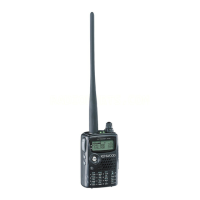40
11 OPERATOR CONVENIENCES
2 While speaking into the microphone using your
normal tone of voice, adjust the VOX Gain by
pressing [ ]/ [ ] until the transceiver reliably
switches to transmit mode each time you speak.
• The setting should not allow background noise
to switch the transceiver to transmit mode.
From the Menu:
1 Press [MNU].
2 Turn the Tuning control or press [ ]/ [ ] to select
Menu No. 21 (VOX GAIN).
3 Press [ ] or [MNU].
4 Turn the Tuning control or press [ ]/ [ ] to select
the desired VOX Gain (default is 4).
• The selectable gain range is from 0 (least
sensitive) to 9 (most sensitive).
• The setting should not allow background noise
to switch the transceiver to transmit mode.
5 Press [ ] or [MNU] to store the setting.
Otherwise, press [ ] or [PTT] to cancel.
VOX DELAY TIME
If the transceiver returns to receive mode too quickly
after you stop speaking, your final word may not be
transmitted. To avoid this, select an appropriate
delay time that allows all of your words to be
transmitted. However, do not make the delay overly
long. There are 2 ways of adjusting the VOX Delay
Time.
When the VOX function is already ON:
Press [ ]/ [ ] to select the desired delay time from
250, 500 (default), 750, 1000, 1500, 2000 and
3000 ms.
• The VOX Delay Time, “D: 500ms” changes
accordingly.
From the Menu:
1 Press [MNU].
2 Turn the Tuning control or press [ ]/ [ ] to select
Menu No. 22 (VOX DELAY).
3 Press [ ] or [MNU].
4 Turn the Tuning control or press [ ]/ [ ] to select
the desired delay time from 250, 500 (default),
750, 1000, 1500, 2000 and 3000 ms.
5 Press [ ] or [MNU] to store the setting.
Otherwise, press [ ] or [PTT] to cancel.
Note:
◆ If you press [PTT] while the VOX function is ON, the VOX
Delay Time is not reflected to the transmission.
◆ If you press [CALL] (if 1750 Hz is programmed) {page 13} to
transmit 1750 Hz tone, the VOX Delay Time is not reflected.
◆ If the DCS function {page 28} is ON, the transceiver remains
in the transmission mode for the VOX Delay Time, then it
sends “Turn-Off Code” to close the receiving parties squelch.
VOX ON BUSY
You can configure the transceiver to force VOX
transmission even if the transceiver is receiving a
signal on A or B-band.
1 Press [MNU].
2 Turn the Tuning control or press [ ]/ [ ] to select
Menu No. 20 (VOXonBUSY).
3 Press [ ] or [MNU].
4 Turn the Tuning control or press [ ]/ [ ] to select
“ON”.
•To suppress the VOX transmission when the
transceiver is receiving a signal, select “OFF”.
5 Press [ ] or [MNU] to store the setting.
Otherwise, press [ ] or [PTT] to cancel.
Note: You can press [PTT] or [CALL] (if 1750 Hz is
programmed) to transmit, regardless of Menu No. 20 (VOXon
BUSY) settings.

